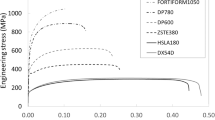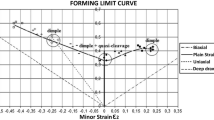Abstract
Springback phenomenon is mainly a problem of residual stresses, which are released after die opening. The use of drawbeads in the blankholders of forming dies is a widely taken measure in order to influence the stress state through the thickness of the sheet material. Besides, blankholder closing force has implications in die design and energy consumption during production. This paper presents a methodology to evaluate the efficiency of different drawbead geometries regarding restraining capacity. An efficiency parameter was created which allows for a comparison between drawbead geometries. It is based on the measurement of the maximal in-plane strain in the test part which can be generated with a determined blankholder force. Finite element simulations using commercial software have been run on a test part, using different drawbead geometries and closing forces. The simulations were experimentally validated using a test die. With the methodology, it is possible to determine the most efficient drawbead geometry for a definite sheet metal part, allowing for reducing die investments and press energy consumption per part produced.















Similar content being viewed by others
References
Bae GH, Song JH, Huh H, Kim SH, Park SH (2007) Simulation-based prediction model of the draw-bead restraining force and its application to sheet metal forming process. J Mater Process Technol 187–188:123–127
Beck S (2000) Control of the deep drawing process through active draw beads. In: Proceedings of the international conference “New developments in sheet metal forming”, Stuttgart, Germany. ISBN 3-88355-292-5
Carden WD, Geng LM, Matlock DK, Wagoner RH (2002) Measurement of springback. Int J Mech Sci 44:79–101
Chalal H, Racz SG, Balan T (2012) Springback of thick sheet AHSS subject to bending under tension. Int J Mech Sci 59:104–114
Dahlke P (2004) High-strength steels—experiences from the tool shop, the press shop and the body in white shop. In: Proceedings of the international conference “New developments in sheet metal forming”, Stuttgart, Germany. ISBN 3-88355-332-8
Eggersten PA, Mattiasson K (2009) On the modeling of the bending-unbending behavior for accurate springback predictions. Int J Mech Sci 51:547–563
Eggersten PA, Mattiasson K (2012) Experiences from experimental and numerical springback studies of a semi-industrial forming tool. Int J Mater Form 5:341–359
Firat M, Kaftanoglu B, Eser O (2008) Sheet metal forming analysis with an emphasis on the springback deformation. J Mater Process Technol 196:135–148
Green DE (2005) Description of numisheet 2005 benchmark #3 stage-1: channel draw with 75% drawbead penetration, Numisheet 2005 Part B, pp 894–904
Hayashi Y, Takagi M (1984) Control of side wall curl in draw-bending of high strength steel sheets. Adv Technol Plast I:735–740
Padmanabhan R, Sung J, Lim H, Oliveira MC, Menezes LF, Wagoner RH (2008) Influence of draw restraining force on the springback in advanced high strength steels. Int J Mater Form Suppl 1:177–180
Smith LM, Zhou YJ, Zhou DJ, Du C, Wanintrudal C (2009) A new experimental test apparatus for angle binder draw bead simulations. J Mater Process Technol 209:4942–4948
WAS (2009) Advanced high strength steel (AHSS) application guidelines, Version 4.1, pp 2–56. World Auto Steel Association, www.worldautosteel.org
Author information
Authors and Affiliations
Corresponding author
Additional information
Technical Editor: Alexandre Mendes Abrao.
Rights and permissions
About this article
Cite this article
Stürmer, L., Härter, I. & de Souza, J.H.C. A study on drawbead restraining force effectiveness. J Braz. Soc. Mech. Sci. Eng. 38, 109–117 (2016). https://doi.org/10.1007/s40430-015-0421-6
Received:
Accepted:
Published:
Issue Date:
DOI: https://doi.org/10.1007/s40430-015-0421-6




